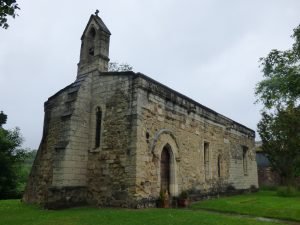The Chapel of St Mary Magdalen in Ripon, was founded by Archbishop Thurstan in the 12th century, it was initially part of the St Mary Magdalen Hospital, serving as a chapel for lepers and later for blind priests.
Category: Hospital
- Bronze Age
- Iron Age
- Roman
- Dark Ages
- Early Christian
- Viking
- Saxon
- Medieval
- Vitrified Fort
- Archaeology Guide
- Guide – Introduction to Critical Thinking in Archaeological Research
- Guide – Challenging Assumptions with Free Thinking
- Guide – Congruence in Archaeological Interpretation: Holistic Analysis
- Guide – Critical Thinking: Lack of Evidence Does Not Mean Evidence of Lack
- Guide – Critical Thinking: The Simple Assumption
- Guide – Applying critical thinking to historic and archaeological research
- Guide – Empathic Archaeology Introduction
- Guide – Landscape Archaeology Introduction
- Guide – What is Landscape Archaeology?
- Guide – The Flora and Fauna of Prehistoric Britain
- Guide: Landscape Archaeology: The Geology of Thornborough
- Guide – Landscape Archaeology: The Geological Environment of Britain
- Guide – Landscape Archaeology: Post-Ice Age Landscape of Thornborough
- Guide – Archaeological Periods in Western Europe
- Guide – Visible Remains
- Guide – Hidden Remains
- Guide – Getting Started
- Guide – Landscape Features
- Guide – Agricultural practices through time
- Guide – Introduction to Glacial Archaeology
- Guide: In Depth – Church Doors and Windows
- Guide – Mining
- Guide – Archaeological Terms
- Guide – Glossary
- Latin Translation – Choosing the meaning of AUG
- Reports
- An introduction to Brigantian Druidry
- Brigantia during the Dark Ages
- Celtic Heads
- Cleave Dyke Defensive System, North Yorkshire
- Finding Bardon – An Arthurian Quest
- Early Christian syncretism and how the old ones hid amongst the new religion
- Rome: The Emperors Claim to Divinity
- Syncretism through the ages
- The Border Reivers
- The Gallus Frontier – Brigantia against the Romans
- The growth of Christianity 50AD – 1100AD
- The Kingdom of Venutius
- The use of the word Lady in relation to water related structures
- The walled gardens of Brigantia
- Yorkshire’s “Sacred Vale” – The Dawn of Brigantia
- The Brigantes of Europe
- Spain
- Galicia
- Biefing – The Myth of Breogán and the Tower of Heracles
- Briefing – Galicia’s Political History and Separatist Sentiment
- Briefing – Geography and Geology of Galicia
- Briefing – Design of Galician Hillforts
- Briefing – Roman Interaction with Galicia and the Iberian Peninsula
- Church of Santa María de Cambre, Cambre near A Coruña
Research Links
Recent Reports
Periods
Select a Child Category
period
67fe61fe019e5
1
1
Loading....
Categories
- Abbey (3)
- Agriculture (1)
- Air Mapping (2)
- Air Photography (2)
- Amphitheatre (1)
- Angle (2)
- Archaeology (77)
- Articles (102)
- AUG (1)
- Augustus (1)
- Barrow (7)
- Battle (1)
- Beacon (1)
- Biography (2)
- Bridge (5)
- Briefing (8)
- Brigantia (87)
- Brigantia Espania (7)
- Brigantian Druidry (1)
- Broch (1)
- Burial Mound (5)
- Castle (5)
- Celtic Industry (1)
- Celtic Life (8)
- Celtic Trade (1)
- Chimney (1)
- Church (23)
- Critical Thinking (7)
- Crosses (1)
- Cursus (2)
- Defensive structure (2)
- Dyke (5)
- Earthworks (21)
- Empathic Archaeology (5)
- Enclosure (8)
- Festivals (2)
- Field Systems (15)
- Fieldwalking (2)
- Finds (24)
- Altar (9)
- Axe (1)
- Celtic Head (7)
- Clock (1)
- Curse Tablet (1)
- Hair Braid – Ring (1)
- Statue (1)
- Folly (4)
- Ford (2)
- Fort (14)
- Free Thinking (7)
- Geography (2)
- Geology (2)
- Geophysics (4)
- Giants (1)
- Glacial Archaeology (2)
- Gods (9)
- Gothic (2)
- Guide (44)
- Hall (1)
- Henge (16)
- Henge Capital of Britain (10)
- Hill Figure (3)
- Hill Fort (40)
- Hospital (1)
- House (1)
- Inscription (4)
- Landscape Archaeology (17)
- Landscape feature (3)
- Latin (3)
- Latin translation (5)
- Leaders (28)
- LiDAR (1)
- Maps (6)
- Marching Camp (5)
- Market (1)
- Mining (4)
- Motte and Bailey (4)
- Mound (1)
- Myth and Legend (3)
- Oppidum (1)
- Period (261)
- Anglo-saxon (4)
- Bronze Age (22)
- Dark Ages (13)
- Dark Ages Brigantia (2)
- Early Christian (29)
- Georgian (2)
- Iron Age (115)
- Jacobite (4)
- Medieval (47)
- Medieval Brigantia (3)
- Mesolithic (6)
- Neolithic (30)
- Norman (36)
- Palaeolithic (3)
- Roman (81)
- Saxon (7)
- Stuart (3)
- Tudor (7)
- Phalera (1)
- Photography (6)
- Priory (2)
- Regional Surveys (7)
- Religious Orders (3)
- Reports (63)
- Research (10)
- Research Tools (4)
- Ring Cairn (1)
- Ritual walkway/pilrimage path (1)
- River Works (1)
- Rock Art (1)
- Roman Villa (1)
- Scotland (3)
- Smelting (1)
- Socratic Thought (1)
- Spain (3)
- Standing Stones (5)
- Stone Circle (4)
- Stories of Brigantia (3)
- Suspect (1)
- The Premonstratensians (2)
- Tower (6)
- Trade (1)
- Translation (5)
- Tribes (24)
- Uncategorized (43)
- Undated (7)
- Viking (3)
- Vitrified Fort (23)
- Walking Guides (2)
- Walled Garden (1)
- Well (1)



